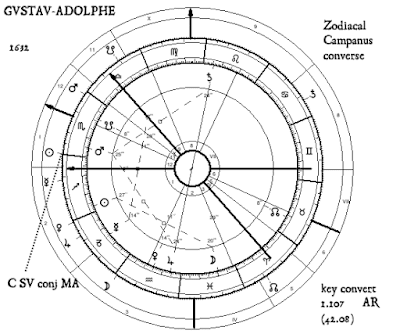Gustavus Adolphus of Sweden (2)
Called "The Great" or "The Lion of the North", this Swedish king was born on December 9, 1594 in Stockholm (Sweden-Finland) - died in the battle of Lützen on November 6, 1632.
birth hour : between 7 and 8h: [Argoli, DDC, 186 7h28 - Placidus, PM, 163, 7h42 - Gadbury, Collection, etc. 31, 19h19 pm (December 8th, then) - Swan J, Speculum Mundi, f. 102-105]
Eleazar de Mauvilon [History of Gustavus Adolphus, King of Sweden, etc. p. 30, t. 1, 1764] gives 7:28 am, citing a "great astrologer".
Several astrologers have studied the case of Gustav II. There was Placidus of Titi and John Gadbury. The latter has calculated two directions compatible with the tragic disappearance of the monarch.
Morin de Villefranche, Astrologia gallica, liber XVII, p. 400
These directions were the subject of an article by Deborah Houlding: an easy introduction to primary directions (2005, 2009) to which I refer the interested reader.
Gustave's death has been related in various ways; it has even been attributed to assassination; Here we relate the details according to the most authentic documents. After a brilliant attack, some Swedish infantry regiments folded. Gustavus seized a half-spades, and going in the midst of them exclaimed: "If after having crossed so many rivers, scaled so many walls and forced so many places, you have not the courage of yourself defend, turn your head at least to see me die. These words gave courage to the fugitives, who again crossed the entrenchments of the Imperialists. Gustavus mounted on horseback, placed himself at the head of the Smaland cavalry to support this infantry. A thick fog covered the battlefield. The king, driven by his ardor, departed from his soldiers, and clashed with the Austrian armour-clads. His horse was wounded in the neck with a pistol bullet; he himself received one that smashed his left arm, so that the bone pierced the sleeve of the coat. He begged the Duke of Saxe-Lauenbourg to take him out of the fray. At the same moment a shot struck him in the back, under the right shoulder (Puffendorf positively accuses the Duke of Saxe-Lauenburg of having fired the second shot, the mortal one.) On the morning of the fight, the king had refused "God is my breastplate," he said, and armour had been a great problem since the wound he had received at Dirschau. he fell off his horse, and his foot being engaged in the stirrup, he was dragged at some distance. Truchsess, the chamberlain, declared that he had been fired about ten paces by an imperial officer (Falkenberg, lieutenant-colonel), who immediately turned, but was immediately pursued and himself killed with a sword. Luchau, to be the Eccles of the Duke of Saxony. This squire was taken by the Imperials. One of the grooms who accompanied the king fell dead, the other wounded (Jacques Eriksson). From all his suite he remained with him only a German page, Leubelfing, who, seeing the king reach out to him, endeavoured to lift him up. Three Austrian cuirass asked Leubelfingen the name of the wounded man; he refused to declare it, and received a pistol shot and two thrusts, of which he died five days later. Gustavus himself called himself: the Austrians, seeing the Swedish cavalry run up, unloaded a pistol in his temple, gave him some sword-strokes, and stripped him, leaving him only his shirt. Several charges were executed on his body, which was found after the battle, covered with wounds and bruises. He was unrecognizable. Transported first to Meuchen, it was embalmed at Weissenfels, by the apothecary Casparus, who counted nine open wounds, and thirteen old scars. His solemn burial took place in the Riddarholm church in Stockholm on March 21, 1634. According to Geyer, thirteen peasants rolled a large stone at the place where the king had fallen: it is the stone called Sckwedenstein (stone Swedish); but the real place where Gustave breathed his last must be forty paces away, on the edge of a field where was planted from an acacia tree.
Such was the death of this great king, aptly nicknamed the Boulevard of Protestantism.
[New universal biography, etc. pp. 878-879, dir. Hoefer, 1858, t. 22]
I. Natal chart
In my first study, I kept the time given by Placidus; I come back here to the one Morin de Villefranche indicates in Astrologia gallica.
Now, if we take again the characteristics of Gustav-Adolphe's natal chart, we see that ALMUTEN is JU, afflicted by SA opposition and square from MA. MO and JU are in fall (resp. PIS and AQU).
According to Lilly, ALMUTEN is VE. SU is HYLEG (and afflicted by SU square).
We observe also in mundo # SU-MA.
II. Primary direction
A. SU conj MA
1. parameters
2. analysis
3. result
zodiacal
mundane
D --> Z C Regio-Campa -0.13. (for AR key)
B. #MO conj MA
1. parameters
2. analysis
3. result
zodiacal
mundane
D --> Z D Regio-Campa 1/AR orb -0.28.
C. MA conj MC
It was this direction that Morin had spotted when Cardinal Richelieu had questioned him about the fate of Gustavus Adolphus.In his La Prévision de l'avenir par l'astrologie [Hachette, 1982, pp. 33-34], A. Barbault gives precisely the example of Gustave-Adolphe, and in particular the primary direction of MC at the conjunction of Mars. Starting from Morin de Villefranche [Astrologia gallica, XVII, 400] who gives the time of birth at 19:13, he comes:
D = AR (MA) - AR (MC) =















Aucun commentaire:
Enregistrer un commentaire
Remarque : Seul un membre de ce blog est autorisé à enregistrer un commentaire.